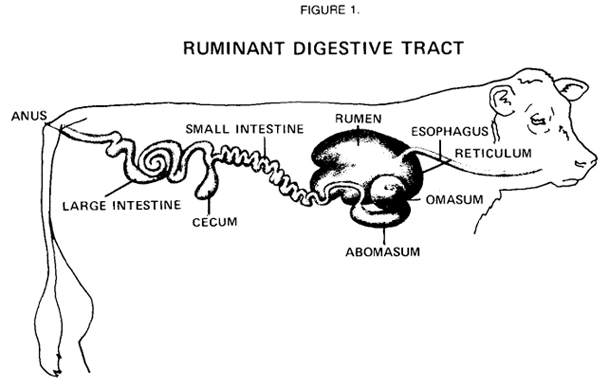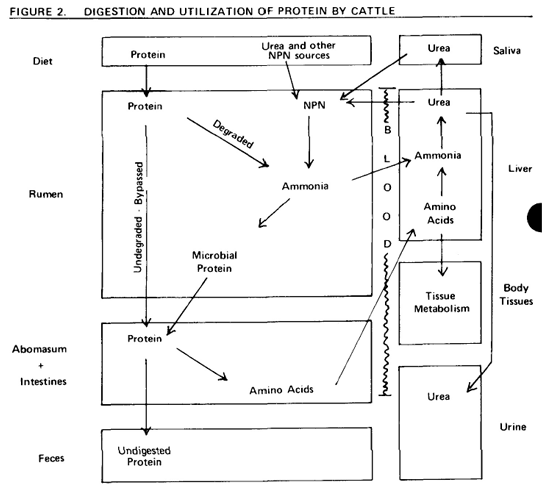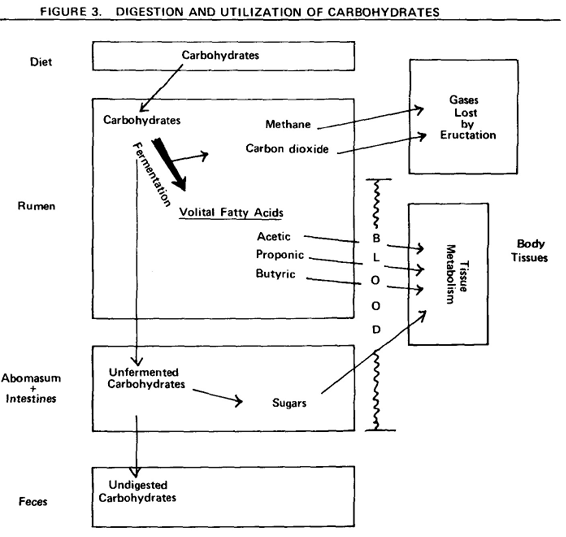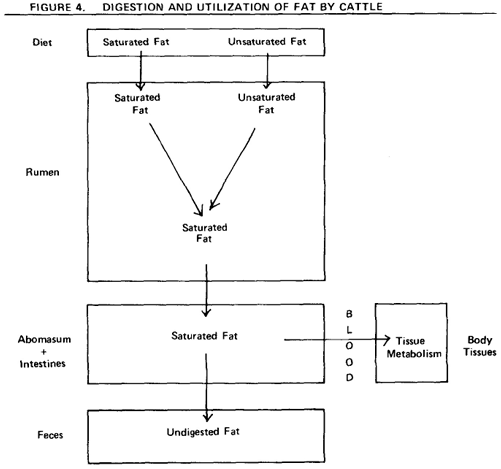People Dont Know Beef Comes From Cows
Whitney Rounds and Dennis B. Herd
Download PDF | Email for Questions
Digestive Tract Beefcake | Rumen Fermentation | Food Passage | Advantages and Disadvantages
Digestion in cattle is similar to digestion in man and certain other animals, except that, in cattle, foods are first subjected to microbial fermentation in the reticulo-rumen. Cattle tin use roughages and other fiberous feedstuffs only through the action of microorganisms which are commonly ingested on feed or obtained from other animals. Microorganisms in the rumen have the unique power to pause down fiberous feedstuffs to obtain the simple nutrients required for their growth. In this procedure, various microbial by-products of no value to the microbe, such equally volatile fatty acids and B vitamins, are produced. These past-products are captivated into the claret and are used as sources of nutrients by the creature. The microorganisms also pass from the rumen to the lower digestive tract, where the are digested and their constituent protein, vitamins and other nutrients are absorbed and utilized past the animal. The relationship of the microbes wiht the host cow is mutually beneficial.
Digestive Tract Anatomy
Man, dogs, poultry and swine accept simple or monogastric stomachs (see Figure i). The monogastric stomach is a pouch-like structure containing glands which secrete hydrochloric acid and digestive enzymes. Monogastric animals exercise not produce enzymes capable of breaking down cellulose, the main source of free energy in forages. Forage consuming species, such every bit cattle and sheep, have intestinal differences which enable them to digest large amounts of fiberous fabric. In cattle and sheep, rumen microbes supply the digestive enzymes necessary for the breakdown of plant cellulose and hemicellulose. The moo-cow has the stomach book and properties necessary to assistance with the microbial digestion. The ruminant digestive tract and the ruminant stomach are shown in Figure 1.
The ruminant tummy is divided into four compartments: the rumen, reticulum, omasum and abomasum. Digesta can menstruum freely betwixt the first 2 compartments, the rumen and reticulum. The reticulo-rumen contains more than 30 percent of the total digestive tract capacity and well-nigh of the microbial activity takes place hither. After sufficient time in the reticulo-rumen, digesta flows into the omasum. The omasum has many folds of tissue, similar to a partially open book, and contains from half-dozen to 8 percent of the total digestive tract capacity. The omasum is thought to help in the reabsorption of water form digesta flowing through it, and to assistance in reducing particle size. Upon leaving the omasum, digesta passes into the abomasum, which is frequently referred to as the true stomach. Similar the stomach of monogastric animals, the abomasum secretes digestive enzymes which prepare digesta for absorption in the pocket-size intestines. Approximately 6 to eight pct of the full digestive tract is taken up past the abomasum.
Feeds cleaved down to their component parts during passage through the ruminant stomach are largely captivated in the small-scale intestines. Assimilation of poly peptide, vitamins, simple carbohydrates, fats and amino acids takes place here. Undigestable material which will not be absorbed passes into the big intestines, where excess moisture is reabsorbed and form is given to what will go the fecal droppings.
Rumen Fermentation
Fermentation in the rumen is made possible by a very stable environment for microbial growth. The normal pH ranges from 5.5 to 7.0, temperature ranges from 37 to 40 degrees centigrade. And food is continuously bachelor in the rumen of properly fed animals. End products of fermentation are continuously removed, either by eructation, by absorption across the rumen wall or past passage out of the rumen to the lower digestive tract. Feed does not only "sit" in the rumen. There is continuous mixing of rumen contents every bit digestive tract muscles contract. The mixing action helps expose food to microbial activeness and pass digesta through the system.


Rumen Microbes. Rumen bacteria have been classified according to the type of food they utilize or the terminate products they producee. Included are bacteria which digest cellulose, hemicellulose, starch, sugar, organic acids, protein and fat, too as bacteria which produce ammonia or methane or synthesize vitamins.
Protozoa found in the rumen are larger than bacteria, and are classified according to cell morphology. Protozoa species are known to vary with the type of diet, time of year and geological location. Protozoa have been known to eat rumen bacteria. Bacteria and protozoa have food value to the cow. Dried microbes incorporate from forty to l percent crude poly peptide which is over 75 percent digestible.
Microbial Metabolism. Microbes in the cow's digestive tract use a portion of the nitrogen and energy from the feed for their own growth and reproduction. Equally they grow, microbes manufacture microbial protein and store free energy in their cells. Microbes themselves become an of import source of food (peculiarly protein) for the cow. During fermentation the microbial population converts a large portion of the feed carbohydrates (sugars, starches, cellulose and hemicelloses) to volatile fatty acids which are the cow's main source of free energy (Figure 3).
The composition of the volatile fatty acids produced in the rumen varies according to the unlike rations fed. Normally, acetic acid would make upwards 60 percent, propionic 22 percent and butyric 16 percent of the total acrid production. In full general, loftier roughage rations volition contain a higher percentage of acetic acid whereas high concentrate rations will outcome in slightly college levels of propionic acrid. Ideally, decreasing acetic and butyric acids and increasing propionic would lead to more efficient beef product. However, high acetate levels are desired for milk fat production. High grain to roughage ratios, some feed processing techniques and certain feed additives promote propionate at the expense of acetate.
Food Passage
Food Passage through the Digestive Tract
The fourth dimension required for food passage through the digestive tract ranges from 1 to three days depending upon characteristics of the nutrient and the specific nutritient involved.
In the mouth, chewing breaks the nutrient into smaller particles. Digestive enzymes in saliva are mixed with food before it passes downward the esophagus into the reticulo-rumen (Figure 1). Although most of the feed undergoes fermentation, small amounts may laissez passer unchanged through the rumen into the omasum and abomausm. Some of the larger nutrient particles will be regurgitated, chewed again and reswallowed. This "chewing of the cud" is important becuase cattle exercise non initially chew their food to the extent that monogastrics practise.
Protein. Poly peptide in the diet is subjected to deposition (partial or extensive) by ruminal microorganisms (Figure two). Microbes degrade institute proteins to diverse degrees and use the resulting ammonia in the synthesis of microbial poly peptide. The extent of protein deposition varies with the blazon and solubility of the protein. This deposition and resynthesis process has advantages and disadvantages. Some high quality proteins may be degraded, thus reducing the quantity of essential amino acids bachelor to the creature. (Estrus and acid handling to reduce poly peptide solubility are currently existence studied as methods of preventing degradation, thus saving the amino acids for utilise by the animal.) On the other manus, extremely depression quality plant proteins may be upgraded during digestions to a college quality microbial protein. Plant proteins not degraded in the rumen along with microbial protein are passed to the lower tract. Digestive enzymes secreted in the abomasum break both establish and microbial protein into their component amino acids which are absorbed from the modest intestines.
Non-Poly peptide Nitrogen tin be used as a substitute for institute nitrogen. Rumen microbes can apply the non-protein nitrogen. Rumen microbes can use the non-protein nitrogen in the synthesis of microbial protein.
Carbohydrates. Carbohydrates in the diet also are degraded by rumen microorganisms (Figure iii). Volatile fatty acids and gases (marsh gas and carbon dioxide) are the end products of this process. Volatile fat acids produced by rumen microbes are captivated directly form the rumen. Gases are eliminated through eructation.
Fiber, a complex carbohydrate, is equanimous of lignin, cellulose and hemicellulose. Lignin is very resistant to microbial assail, therefore little of information technology is digested. Cellulose is more readily digested than lignin, and hemicellulose is the most digestible of the iii. Starches and sugars also are readily converted to acids and gases. Unfermented feed residues and microbial cells are left to pass through the omasum to the abomasum. In the abomasum, the secretion of digestive enzymes prepares the foodstuffs for assimilation in the minor intestine.
Fats. Some hydrogenation (addition of hydrogen) of unsaturated acids takes place in the rumen (Figure 4). Unsaturated dietary fat (soft fatty) subjected to microbial activeness in the rumen is transformed to a hard or a saturated fat. Most fats are passed to the abomasum and pocket-size intestine where absorption occurs.



Advantages and Disadvantages
Reward of Rumen Fermentation
Fermentation past the rumen microorganisms give the ruminant animate being several unique capabilities:
1. Forage Utilization
Forage and roughage account for a large quantity of the full world feed resource. Rumen microorganisms, through the production of enzymes, allow the ruminant beast to use the fiberous portion of these roughages as an energy source.
two. Not-protein Nitrogen Utilization
Rumen microorganisms can manufacture protein form non-protein nitrogen. This microbial protein is afterward digested and supplies the brute with needed amino acids. Nonruminants must obtain essential amino acids directly course their diets.
3. Vitamin Synthesis
Rumen microorganisms tin can sythesize the B-complex vitamins and vitamin K. Dietary supplementation is not required, except in sick animals where rumen function is impaired.
Disadvantages of Rumen Fermentation
Fermentation in the rumen and reticulum may cause inefficient conversions of dietary constituents:
1. Waste Gas Production
Carbon dioxide and methyl hydride are by-products of the breakdown of carbohydrates, and are eliminated from the rumen. Sugars and starches would exist of more benefit if they could be passed to the lower digestive tract for assimilation as carbohydrate.
2. Wasted Protein and Nitrogen
Ammonia and organic acids are the end result of poly peptide breakdown. Some of the resulting ammonia is recombined to class microbial protein. Still, nether some atmospheric condition ammonia is lost, absorbed across the rumen wall and excreted in the urine. The loss of ammonia in the digestive process is inefficient.
three. Heat of Fermentation
Rumen microbes breaking down feedstuffs and reforming them generate heat. This estrus of fermentation is a disadvantage in most instances. In cold environments, however, this estrus volition help meet the animal'southward maintenance energy requirement.
iv. Digestive Disturbances
Bloat and acidosis are cases of rumen malfunciton. Bloat results when fermentation gases are produced faster than they can be disposed of. Acidosis is the result of an excessive breakdown of readily available carbohydrates. In feedlot cattle, acidosis usually leads to an erosion of the rumen wall and liver abscesses.
The ruminant beast is unique because of the mutually beneficial symbiotic relationship that exists with the microbes living in its digestive tract. Through the action of these microbes, high-fiber feed sources get assets. Non-protein nitrogen compounds tin can be used by the ruminant in the production of microbial protein. Animals with simple stomachs cannot apply cellulose or not-protein nitrogen.
Render to Peak
Source: https://beefskillathon.tamu.edu/cows-digestive-system/
Post a Comment for "People Dont Know Beef Comes From Cows"